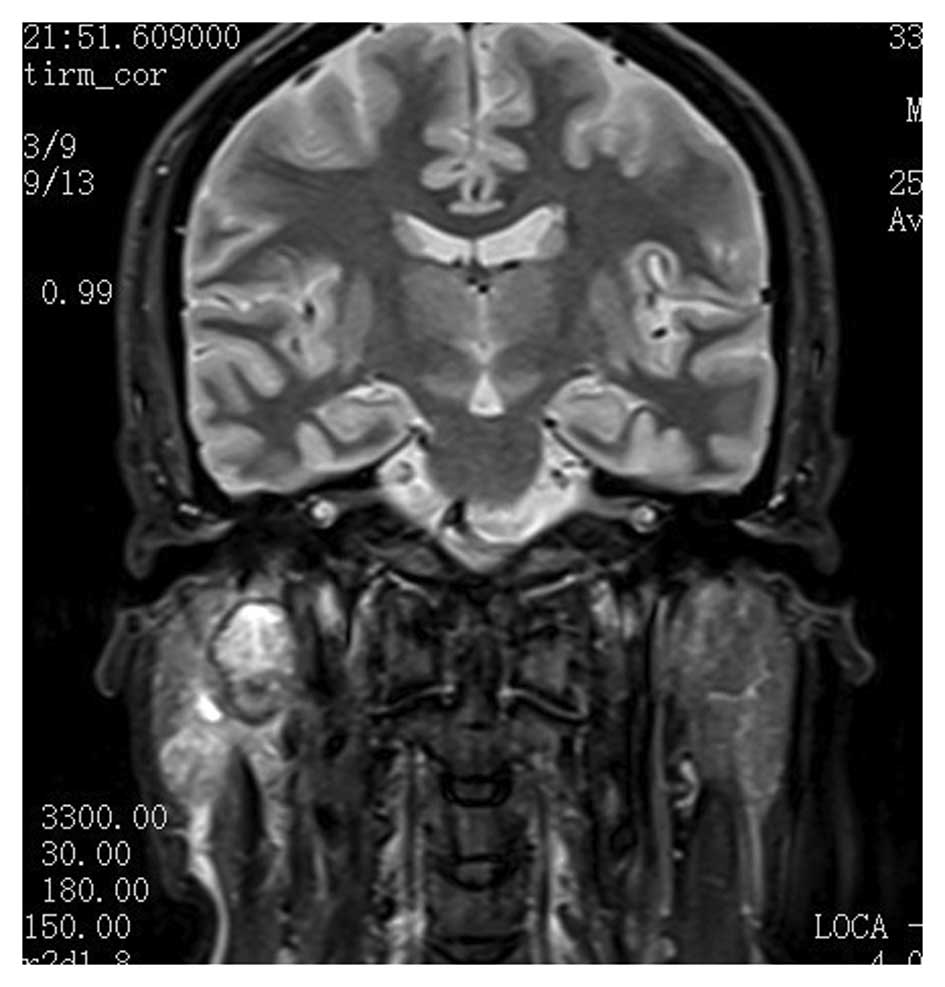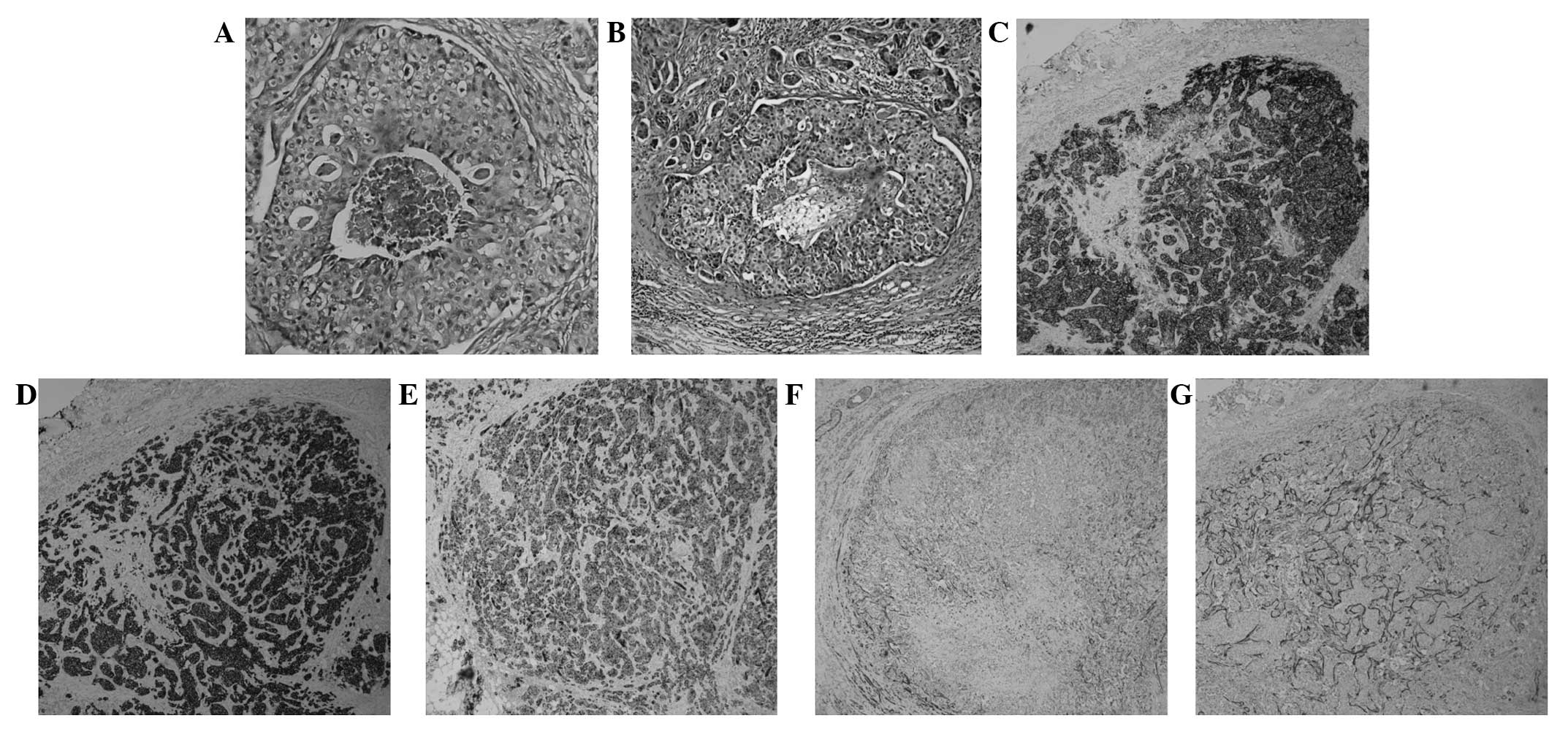Salivary duct carcinoma of the parotid gland: A case report and review of the literature
- Authors:
- Shule Xie
- Hongyu Yang
- Marius Bredell
- Shiyue Shen
- Huijun Yang
- Long Jin
- Shanshan Zhang
View Affiliations
Affiliations: Department of Oral and Maxillofacial Surgery, Peking University Shenzhen Hospital, Shenzhen, Guangdong 518001, P.R. China, Department of Cranio-maxillofacial and Oral Surgery, University Hospital Zürich, Zurich 8091, Switzerland
- Published online on: October 31, 2014 https://doi.org/10.3892/ol.2014.2655
-
Pages:
371-374
Metrics: Total
Views: 0 (Spandidos Publications: | PMC Statistics: )
Metrics: Total PDF Downloads: 0 (Spandidos Publications: | PMC Statistics: )
This article is mentioned in:
Abstract
Salivary duct carcinoma (SDC) is a rare and aggressive parotid malignancy that most commonly affects males in the fifth and sixth decades of life. Histopathology specimens obtained from SDC patients demonstrate a resemblance to ductal carcinoma of the breast. Therefore, to distinguish SDC from breast ductal carcinoma, several immunohistochemical markers exist that may enable surgeons to make an accurate diagnosis. In this study, the case of a 54-year-old male with salivary duct carcinoma of the right parotid gland is presented. The results of the present case study revealed that the SDC sample was positive for the expression of human epidermal growth factor 2 (Her‑2), cytokeratin (CK) 8/CK 18, p63, high molecular weight CK and calponin, and negative for expression of the estrogen receptor and progesterone receptor. Based on the result, an ipsilateral selective neck dissection followed by adjuvant post‑operative radiation therapy was suitable at the primary treatment stage. At one year of follow-up, the patient was alive and free of recurrence. In advanced cases of SDC, treatment with anti‑HER‑2 monoclonal antibodies, such as trastuzumab, is recommended.
View References
|
1
|
Kleinsasser O, Klein HJ and Hübner G:
Salivary duct carcinoma. A group of salivary gland tumors analogous
to mammary duct carcinoma. Arch Klin Exp Ohren Nasen
Kehlkopfheilkd. 192:100–105. 1968.(In German). View Article : Google Scholar
|
|
2
|
Valeri RM, Hadjileontis C, Skordalaki A,
Pandidou A, Vahtsevanos C and Destouni H: Salivary duct carcinoma
of the parotid gland: report of a rare case with a comparative
study of aspiration cytology and histomorphology. Acta Cytol.
49:61–64. 2005. View Article : Google Scholar : PubMed/NCBI
|
|
3
|
Ellis GL and Auclair PL: Tumors of the
Salivary Glands; Salivary Duct Carcinoma. Atlas Tumor of Pathology.
3rd series. Rosai J: Armed Forces Institute of Pathology;
Washington DC: pp. 455–488. 1996
|
|
4
|
Lewis JE, McKinney BC, Weiland LH,
Ferreiro JA and Olsen KD: Salivary duct carcinoma.
Clinicopathologic and immunohistochemical review of 26 cases.
Cancer. 77:223–230. 1996. View Article : Google Scholar : PubMed/NCBI
|
|
5
|
Seifert G, Brocheriou C, Cardesa A and
Eveson JW: WHO International Histological Classification of
Tumours. Tentative Histological Classification of Salivary Gland
Tumours. Pathol Res Pract. 186:555–581. 1990. View Article : Google Scholar : PubMed/NCBI
|
|
6
|
BenJelloun H, Maazouzi A, Benchakroun N,
Acharki A, Tawfiq N, Saharoui S and Benider A: Salivary duct
carcinoma of the parotid gland: report of two cases and literature
review. Cancer Radiother. 8:383–386. 2004.(In French). View Article : Google Scholar : PubMed/NCBI
|
|
7
|
Brandwein-Gensler MS, Skálová A and Nagao
T: Salivary duct carcinoma Tumours of the Salivary Glands. World
Health Organization Classification of Tumours Pathology and
Genetics of Head and Neck Tumours. Barnes EL, Eveson JW, Reichart P
and Sidransky D: IARC Press; Lyon, France: pp. 236–237. 2005
|
|
8
|
Simpson RHW: salivary duct carcinoma: new
developments - morphological variants including pure in situ high
grade lesions; proposed molecular classification. Head Neck Pathol.
7(Suppl 1): S48–S58. 2013. View Article : Google Scholar
|
|
9
|
Nikitakis NG, Tosios KI, Papanikolaou VS,
Rivera H, Papanicolaou SI and Ioffe OB: Immunohistochemical
expression of cytokeratins 7 and 20 in malignant salivary gland
tumors. Mod Pathol. 17:407–415. 2004. View Article : Google Scholar : PubMed/NCBI
|
|
10
|
Johnson CJ, Barry MB, Vasef MA and Deyoung
BR: Her-2/neu expression in salivary duct carcinoma: an
immunohistochemical and chromogenic in situ hybridization study.
Appl Immunohistochem Mol Morphol. 16:54–58. 2008.
|
|
11
|
Delgado R, Klimstra D and Albores-Saavedra
J: Low grade salivary duct carcinoma. A distinctive variant with a
low grade histology and a predominant intraductal growth pattern.
Cancer. 78:958–967. 1996. View Article : Google Scholar : PubMed/NCBI
|
|
12
|
Jamal AM, Sun ZJ, Chen XM and Zhao YF:
Salivary duct carcinoma of the parotid gland: case report and
review of the literature. J Oral Maxillofac Surg. 66:1708–1713.
2008. View Article : Google Scholar : PubMed/NCBI
|
|
13
|
di Palma S, Whitaker S, Potter K and
Pitkin L: Carcinoma ex pleomorphic adenoma successfully treated
with trastuzumab and radiotherapy. Virchows Arch. 461(Suppl 1):
S1442012.
|











